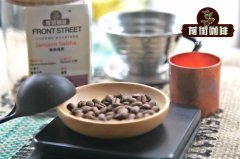Cameroon Coffee introduction: how is Cameroon Coffee? is Cameroon Coffee of good quality?

Professional coffee knowledge exchange more coffee bean information please follow the coffee workshop (Wechat official account cafe_style)
Cameroon Cameroon
Location: Africa (Midwest)
Coffee characteristics: Arabica coffee was planted in Cameroon in 1913. Its variety is Jamaica's Blue Mountain Coffee, which has a rich and soft taste.
Cameroon coffee comes from the western plateau of the Republic of Cameroon in West Africa, known as "Little Africa". Cameroun Cameroon coffee is washed and then selected by hand. The smell is obvious.
Steps for farmers to deal with:
a. Harvest and select ripe coffee cherries, remove moth-eaten beans and unripe beans, and put them into a large pool to remove coffee cherries floating on the water.
b. After picking the coffee cherries, the peel and pulp are removed and put into the fermentation pond. the fermentation time depends on the ambient temperature and the experience of farmers.
c. Wash and remove the surface mucous membrane of the fermented coffee, leaving only the coffee wrapped in the wet endocarp shell.
d. Dry the coffee with an endocarp shell outside the farmer's house for about two weeks until the farmer thinks the coffee is dry enough (hear the sound of a hollow shell when the coffee is shaken in his hand).
Farmers use Pita Bread Plain of the farm to send these raw beans to the raw bean processing plant, collect these raw beans, and check the dryness (no equipment is used here). When the same batch of secondary beans collected is placed in the bean trough of the processing plant, check the humidity of the hygrometer. When the humidity is higher than 13%, this batch of raw beans will be exposed to the sun again before being shelled in the machine. The above step b. And d. Will affect the green degree of raw beans, no two farmers have the same operation methods and the same environment. In the past eight years of experience in this raw bean treatment, it has not been found that the green depth of the raw bean has an important impact on the change of the cup test. In the 1960s, because some scientists claimed that JAVA varieties had better yields and smaller trees, the Cameroonian government sent these varieties of coffee seeds to farmers. Many farmers take the seed and try to plant it, but do not fully accept the JAVA seed. However, the mixing of JAVA species and native species is one of the reasons why white beans sometimes appear. These white beans should not be confused with the occasional floating beans (dead beans), but they are usually picked out by hand in the processing plant. In addition to these floating beans, processing plant workers should pick out all black beans and worm-eaten beans, but physical damage or other machines crushed by machines.
The cultivation of Cameroon began in 1913, and the varieties introduced in the early days are the same as those in Mount Canada, but the coffee industry has been in decline for a long time because of the prosperity of the country. In the 1980s, a large number of coffee products were exported to Taibusta. In recent years, due to the strengthening of the management of the state coffee supervision bureau, there has been a substantial increase in the volume of coffee. The feeling of Cajun's coffee is different from that of ordinary African coffee. Bright and clear is its basic feature and soft taste.
Glass test notes: clean, bright orange and lemon aromas, a hint of nutty sweetness, a supple palate with bright lemon and nutty aromas, with a rich sweetness on the finish.
Important Notice :
前街咖啡 FrontStreet Coffee has moved to new addredd:
FrontStreet Coffee Address: 315,Donghua East Road,GuangZhou
Tel:020 38364473
- Prev

Do you know the origin of the name of Arabica coffee beans after drinking coffee for such a long time?
Professional coffee knowledge exchange more information about coffee beans Please follow the coffee workshop (Wechat official account cafe_style) before we know the origin of Arabica, let's know the name of the origin of coffee. Originally, coffee was named kaffa bunn (meaning, fruit from the Esakafa region (bunn means fruit). By the Ethiopians to the war
- Next

Cameroon boutique coffee cooperative introduction: Boyo cooperative PB round beans
Professional coffee knowledge exchange more coffee bean information please follow the coffee workshop (Wechat official account cafe_style) is suitable for espresso deep-roasted coffee beans. The cultivation of Arabica coffee trees in Cameroon (Cameroon) began in 1913 as the Blue Mountain Coffee from Jamaica, but the country also produces large quantities of Robbins coffee. The quality, characteristics and production of Cameroon Coffee
Related
- Beginners will see the "Coffee pull flower" guide!
- What is the difference between ice blog purified milk and ordinary milk coffee?
- Why is the Philippines the largest producer of crops in Liberia?
- For coffee extraction, should the fine powder be retained?
- How does extracted espresso fill pressed powder? How much strength does it take to press the powder?
- How to make jasmine cold extract coffee? Is the jasmine + latte good?
- Will this little toy really make the coffee taste better? How does Lily Drip affect coffee extraction?
- Will the action of slapping the filter cup also affect coffee extraction?
- What's the difference between powder-to-water ratio and powder-to-liquid ratio?
- What is the Ethiopian local species? What does it have to do with Heirloom native species?

